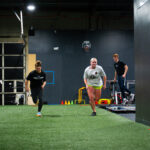Speed and Agility Training for Explosive Performance
Whether you’re a football player, basketball athlete, or track star, speed and agility training is essential. It not only sharpens your reflexes but also improves coordination and control. Let’s dive into how you can benefit from adding speed and agility training to your routine.
Why Speed and Agility Training Matters
Speed and agility training helps athletes react faster, change direction more efficiently, and reduce injury risk. These skills are vital in sports that demand quick movement and decision-making.
Besides, building speed and agility means improving your overall athleticism. In fact, many professional trainers prioritize these elements in their programs. That’s because they know how much they impact real-world game performance.
Key Benefits of Speed and Agility Training
-
Improved Coordination
Drills that enhance agility also train your body and brain to work together. Over time, this sharpens your overall movement. -
Faster Reaction Times
Speed and agility training often includes start-stop drills and rapid footwork. These develop explosive speed, helping you outpace competitors. -
Better Balance and Stability
Lateral movements and multi-directional drills build balance. This becomes especially important when you’re navigating tough terrains or tight spaces.
Best Speed and Agility Drills to Try
Let’s take a look at the most effective speed and agility training drills:
Ladder Drills
Use an agility ladder to perform high-knee and lateral step exercises. These improve foot speed and coordination.
Cone Drills
Set up cones in zig-zag or T-patterns. Practice sprinting between them to enhance direction change and acceleration.
Shuttle Runs
Also known as suicide runs, this drill boosts cardio and trains explosive speed. It’s a favorite among elite athletes.
Plyometric Jumps
Jump squats and box jumps are great for leg power. They directly contribute to improved sprinting and quickness.
For a detailed guide, check the NSCA’s speed and agility principles.
How to Structure Your Training
To see real progress, consistency is key. Here’s a weekly layout for your speed and agility training:
-
Day 1: Ladder drills and cone work
-
Day 2: Plyometrics and shuttle runs
-
Day 3: Light recovery and mobility work
-
Day 4: Repeat Day 1 or combine exercises
Always warm up before drills and cool down afterward. This keeps you safe and enhances performance over time.
Common Mistakes to Avoid
Even the best athletes make errors. Avoid these common pitfalls in your speed and agility training:
-
Skipping warm-ups
-
Doing drills too fast with poor form
-
Ignoring rest days
-
Not tracking progress
Training smart is just as important as training hard. Pay attention to your form and take feedback seriously.
Integrating Speed and Agility Training Into Sports Practice
You don’t need to separate speed and agility training from your regular practice. Instead, incorporate it during warm-ups or as skill-specific drills.
For example, soccer players can do cone drills with a ball. Basketball players can combine agility ladders with dribbling. These sport-specific tweaks make training more relevant and effective.
You’ll find that professional coaches at places like Next Level Athletics USA often integrate these methods seamlessly.
Final Thoughts
Speed and agility training is more than a set of drills. It’s a game-changer for anyone serious about improving athletic performance. With proper execution, you’ll not only run faster and move smarter but also outshine your competition.
Start slow, stay consistent, and push your limits. The rewards are worth the effort. By focusing on these skills, you’ll unlock your full potential.


Recent Comments